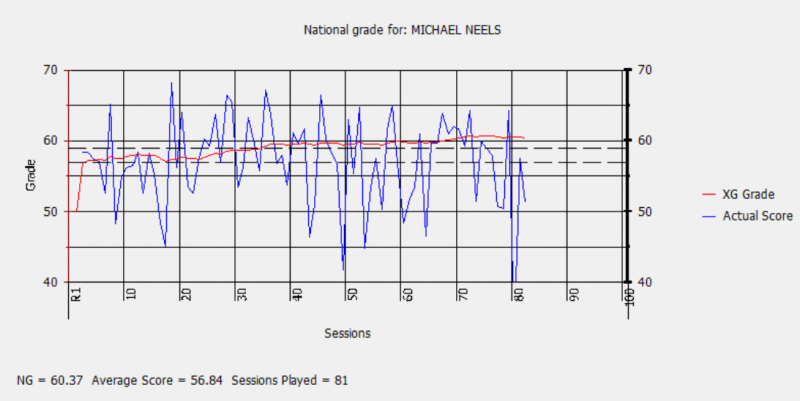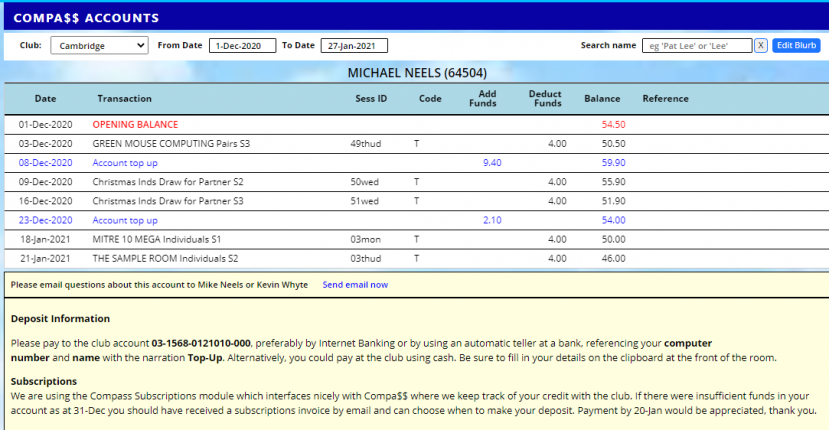More BIG Steps Forward for X-Clubs ... and Bridge in New Zealand
Bob Fearn, as many will know, is the author of Compass scoring which is the engine powering X-Clubs and, for the last four years, the NZ-Wide Babich Simultaneous Pairs. In 2018 Bob took an interest in scoping out a National Grading System (NGS) for use in New Zealand. An NZB NGS would open up a whole new dimension to our game - handicaps. Bridge players could then go out to beat their handicap not their playmates. This challenge became available for all players of X-Club deals 1i 2019.
Bob completed this massive project using the X-Clubs data-set as a basis. In effect all players of X-Club hands earn an X-Clubs rating. Let's call it XG because it's a closed shop based on C-point club bridge played with the same hands - a very different situation from a true NGS which would include both club and tournament results and, for about half of all clubs, no comparison based on the same cards being played. XG ratings opened the door to provide across-the-field handicapped results.
Calculating everyone's XG involves a huge amount of data crunching which happens weekly so that any score changes get incorporated. The method closely parallels the EBU model and involves consideration of your XG, your partners' XG's, and the combined XG's of all your opponents for your week's bridge just gone. XG's are calculated over the most recent 2000 boards before old scores begin dropping off. More recent scores get more weighting than older ones. A minimum of 300 boards - about 13 sessions - need to be played before an XG starts to settle down - see the graph below. A basic example of how the calculation is done is attached below. Click to download it.
Starting from Week 04 in 2019 a complete summary of over 3500 X-Clubbers has been posted along with the weekly Leagues tables.
Every result Ladder - two per day - comes with sortable columns - especially XG Rating, XG Handicap Result, XG Handicap Placing, XG Status. An example:

Just click on any of the green column headers to sort as desired - example

The four categories of XG Status U, E, M,?? are Unpublished (played < 150 boards), Evolving (played between 150 and 1000 boards), Mature (played > 1000 boards) and Unknown which applies to our unaffiliated clubs - eg Doubtless Bay and House of Cards. This is because it takes a while for the XG's to settle down - see graph below as an example. Thus, a reasonable player who is status U has a good chance at coming top on the Handicap as their XG will be assigned by defaults based on NZB Rank ... until they get beyond 6-7 X-Club sessions.
Remember .. all the columns in the Ladder may be sorted by clicking on the green column headers.
 Sample Graph
Sample Graph
In voluntary Covid lockdown for over a year in Seattle Bob has pulled out all stops to develop a fully-fledged NGS based on all results files submitted to NZB - that is both tournaments and random club play while waiting for the Board of NZ Bridge to accept and implement this fulsome NGS-on-a-plate. But wait - there's even more! From a standing start of never having dabbled in web programming Bob produced an interface to a tabulation like this. It can be found by clicking here - you'll need to create a login for yourself. Bob's utility can export an individual's record to Excel (sample attached below), produce a graph, export a summary of everyone's standings to Excel and much more. Of interest to users of Compa$$, Bob's new utility for cashless bridge, there is provision for people to view their own account statements online.
 Compa$$ Statement
Compa$$ Statement
Separate handicapped results ladders are now published for each X-Clubs session.
NOW - back to handicapping - the Main Course: Bob has moved beyond what we understand any other scoring system to have done. By applying the same methodology as used in the weekly recalculation of everyone's XG rating, Compass clubs (and possibly NZ Scorer clubs too, we have heard) can now generate handicaps tailored to each session after the raw results are known. Starting with the average of each pairs' XG's and modifying that for the Strength of their opponents we can now come up with a balanced set of handicaps to apply to the raw results. The "handicap" is, in effect, the difference between a pair's Raw and Expected scores in the field they played. An indication that this is a fair and equitable method of handicapping is the fact that the sum of all handicaps in the field is always zero. That the weightings applied balance out to a net zero sum is mathematically provable. Compass clubs need only specify the Handicap List as List 19 in the Club Calendar of Events (or choose to select the List 19 (NG/XG Handicapping)under Edit Options when viewing the session) for these new Dynamic Handicaps to be applied.
Further .. for non-Compass clubs playing X-Club deals Bob is thoughtfully providing weekly text file updates of their members' latest XG ratings so that those clubs too have the basis to enjoy the new Dynamic Handicapping facility. Dynamic handicaps must surely form the basis of any NZB handicapping system once NZB adopts Bob's National Grading System. Meanwhile ... it's just X-Clubs clubs that have access to this fantastic new facility.
Non-X-Clubbers .. are you up for battling your handicap? Talk to your committee today about giving X-Clubs a try. It's free. It's easy. Join the 50-odd other NZ clubs that play the same hands simultaneously every day. NB - in the 50 weeks leading up to July 2021 over 6,000 individual players and 21,000 pairs played in at least one X-Clubs session.
| Attachment | Size |
|---|---|
| XG - A practical example.doc | 32.5 KB |
| XG Record for 64504 Michael Neels.xls | 68.5 KB |
